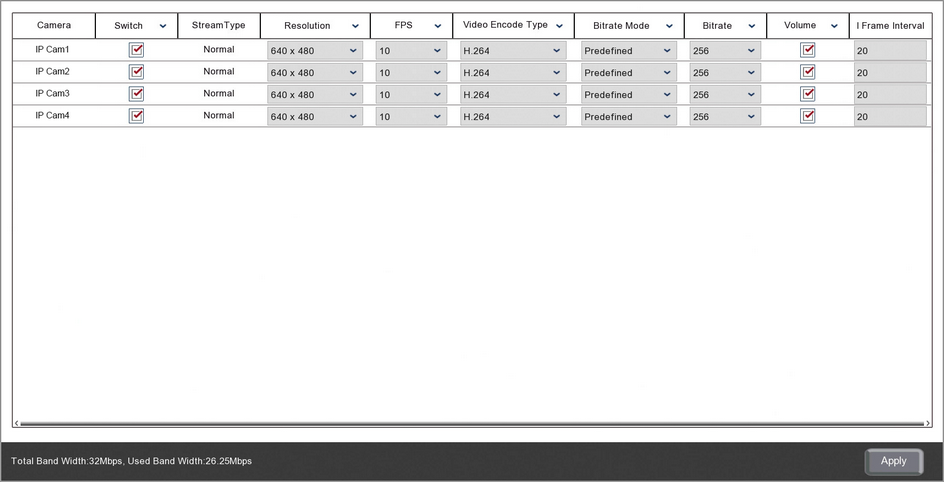You can configure the mobilestream quality for compatible IP cameras in the Encode - Mobilestream sub-menu. The settings for mobilestreams are saved on the camera and not the recorder. As only IP cameras have this functionality you will only be able to configure mobilestreams for IP cameras.
The mobilestream allows you to create a low quality stream for each camera which is optimised for viewing the recorder from the mobile app. As mobile internet connections can be slow in some areas trying to view multiple HD images can be difficult. By creating a low resolution stream you are still able to view multiple cameras at one time on limited bandwidth. Often the difference between the mainstream and mobilestream isn't too noticeable when viewed on a mobile device as screen is so small.
The recorder will always record the higher quality mainstream so you will always have high quality footage if needed. The mobilestream is simply there to over come performance issues when viewing remotely if required.
The settings available will differ depending on recorder, camera type and camera model.

Camera
Lists all channels on the recorder.
Enabling & Disabling The Mobilestream
You can enable or disable the mobilestream for each camera by ticking or unticking the Switch check box.
When the mobile stream is enabled on a camera, the mobilestream option will become available when choosing the stream type for that camera on the Zip Vision PC client software or mobile app.
Stream Type
As the mobilestream is not recorded and ETR is not available only the Normal Stream Type is available.
Resolution
You can set the recording resolution for each camera from the Resolution drop down list. The resolutions available will depend on the camera.
Frames Per Second (FPS)
The frame rate is how many images are captured per second and determines how smooth your recorded footage appears. You can set the frame rate in the FPS drop down list.
A higher frame rate produces smother footage but takes up more storage space. For example TV shows are usually filmed at 24 frames per second however this is unnecessary for most CCTV Systems. A frame rate of 12 frames per second would still capture 12 high resolution images every second.
Video Encode Type
The video encoding type is the compression technique for the video footage and can be set in the Video Encode Type drop down list.
H.265 is a clever compression technique that is twice as effective as H.264. This means you can effectively stream at double the quality while still using the same bandwidth.
However, you may wish to record using H.264 encoding if you if you are viewing the stream on a device which doesn't support H.265.
Bitrate & Bitrate Mode
How you set the Bitrate Mode changes the options available when setting the Bitrate.
If you set the Birate Mode as Predifined you can then choose one of the commonly used pre-set bitrates from the Bitrate drop down list.
When you set the Bitrate Mode to User-defined you can manually enter a specific bitrate into the Bitrate column.
Just remember that the bitrate is the amount of data transferred per second so a high bitrate will produce a high quality image which requires a faster internet speed. A low bitrate will produce a low quality image better for slower internet speeds.
Enabling Audio
You can enable or disable audio recording for each channel by ticking or unticking the Volume check box.
I Frame Interval
I Frames is a compression technique used to create smaller video files. It works by taking one key frame called an I Frame which the recorder will then use as a reference point. For each frame after the I Frame the recorder will only capture parts of the image which have changed rather than capturing the entire image.
With the I Frame Interval you set how often a new I Frame is captured by setting the number of frames between each I Frame. Setting the interval too low and the I Frame will become ineffective as there is such a short time between each reference point. On the other hand, if the interval is too high so much may have changed between the I Frame and the current frame that the recorder is effectively capturing and entire new image anyway.
As a rule of thumb we recommend setting the I Frame Interval at double the frame rate so that a new I Frame is captured every 2 seconds.
For example if the frame rate is 12 frame per second (FPS) the I Frame Interval would be set as 24 so that the recorder captures a new I Frame every 24 frames.
Saving Changes
Once you are happy with your settings click the Apply button to save them. Alternatively you can right click with the mouse to exit the Mainstream menu without saving changes.